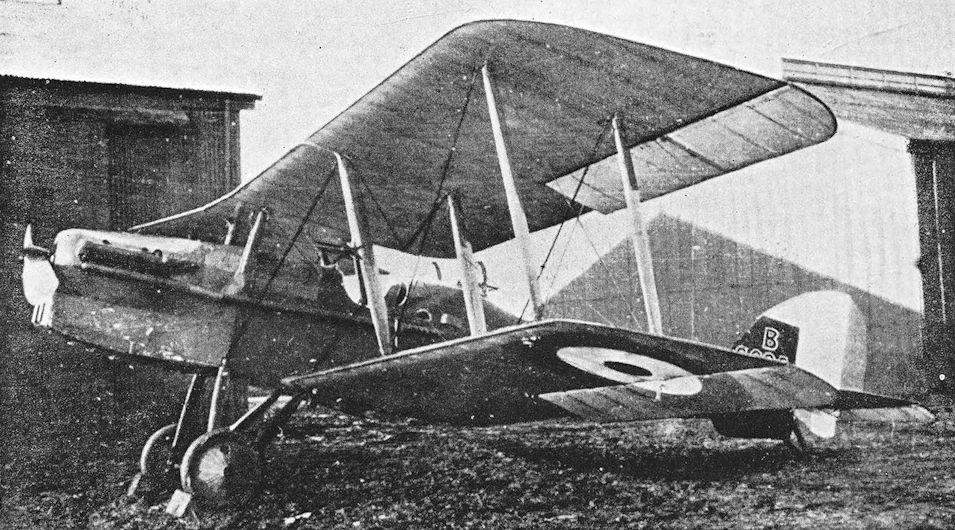
Описание
Страна: Великобритания
Год: 1917
O.Tapper Armstrong Whitworth Aircraft since 1913 (Putnam)
R.T.1
At the time of Green's and Lloyd's move to Coventry, the factory was occupied with large-scale production of the R.E.8, one of the aircraft which Lloyd had worked on while still at Farnborough: it was appropriate, therefore, that this was the aeroplane that formed the basis for the design that was the first to carry the Siddeley Deasy name. Known as the R.T.1, this aeroplane was an attempt to improve on the R.E.8 which, in the RFC, had earned a reputation, not altogether justified, for shedding its overhanging top wing in a dive; it was also reputed to have a dangerous tendency to spin. It was probably more in an endeavour to eliminate these characteristics, rather than to improve the performance, that was the purpose behind the R.T.1 design.
The fuselage of the R.T.1 was essentially the same as that of the R.E.8, but the wings were of entirely new design, being of equal span with two-bay bracing and with the top wing having a greater chord than that of the bottom. Modifications to the fuselage consisted only of raising the observer's gun-ring by a few inches and providing a deeper fuselage top fairing to match. The horizontal tailplane was similar to that of the R.E.8, but the fin and rudder were both of greater area and with a more rounded shape. The small ventral fin of the R.E.8 was retained.
Only three R.T.1s were built, each one growing from a fuselage taken from a batch of 150 R.E.8s then on the Siddeley Deasy production line. The first R.T.1 was powered by a 200 hp Hispano-Suiza engine and fitted with a nose radiator similar in appearance to that of the S.E.5; it bore the serial number B6625. The second aeroplane, B6626, had the same engine as the R.E.8, an RAF 4A, developing 150 hp, in a standard R.E.8 mounting, whilst the third aircraft, the final version, reverted to the 200 hp Hispano-Suiza engine, this time enclosed in a neatly rounded cowling with an underslung radiator. In this version, as with the RAF-powered aircraft, the engine exhaust gases were discharged over the top wing by means of twin stacks. The third aircraft also had modified wingtips and horn-balanced ailerons with rounded tips.
The first flight of the R.T.1 was made from Radford aerodrome by J. H. James, later to become well known for his exploits with the Gloster 'Bamel' racer. He had with him as passenger the designer John Lloyd, who vividly recalls that a prolonged spin made this first flight more memorable than most. The date of the first flight is uncertain, but it is known that the second aircraft, the one with the RAF engine, was undergoing official tests by December 1917.
As compared with the R.E.8, the wing area of the R.T.1 was increased by some 12 per cent, with a wing loading of 6 lb/sq ft, as against nearly 7 lb/sq ft in the case of the R.E.8. In spite of this, the R.T.1 with the same engine was as fast as the R.E.8, clocking 101 mph at 6,500 ft, but, as might be expected, the climb performance was better, the R.T.1 reaching an altitude of 10,000 ft in 19.2 min, while the service ceiling was 16,000 ft, some 2,500 ft higher than that of the R.E.8. The view forward and downward from the pilot's seat of the R.T.1 had been criticized and to improve it a gap was cut in the lower wing root; this had the effect of reducing the speed by about 2 mph at 15,000 ft and increasing the time taken to reach 10,000 ft by about 3 1/2 min. The R.T.1 with the 200 hp Hispano-Suiza engine, and in its final form with the rounded nose, was tested in March 1919 and proved to be some 10 mph faster than the earlier version and to have a service ceiling higher by some 2,000 ft. The aircraft was reported to handle well and one of them underwent Service trials on the Western Front, whilst the other two went to training units; however, it must have been fairly clear from the start that there was little prospect of the R.T.1 going into production, and it seems probable that the design was undertaken more as an exercise for the newly established Siddeley Deasy design team than as a serious attempt to find a replacement for the R.E.8.
R.T.1
Dimensions: Span 41 ft 9 in (12.73 m); length 27 ft 8 in (8.43 m); height 11 ft 7 in (3.53 m); wing area 433 sq ft (40. 23 sq m).
150 hp RAF 4A 100 hp Hispano-Suiza
Max weight: 2,590 lb (1,175 kg) 2.707 lb (1,228 kg)
Empty weight: 1,773 lb (804kg) 1,803 lb (818kg)
Max speed
6,500 ft(1,981 m): 101 mph (163 km/hr}
10,000 ft (3.048 m): 98 mph (158 km/hr) 108 mph (174 km/hr)
15.000 ft (4.572 m): 91 mph (147 km/hr) 100 mph (161 km/hr}
Climb
to 6.500 ft (1,981 m): 10.5min 10.6min
to 10.000 ft(3.048 m): 19.2min 18.5 min
to 15,000 ft(4,572m}: 41.5min 36.4 min
Service ceiling: 16.000ft(4.877m} 18.000ft(5,486 m)
Описание:
- O.Tapper Armstrong Whitworth Aircraft since 1913 (Putnam)
- J.Bruce British Aeroplanes 1914-1918 (Putnam)
- H.King Armament of British Aircraft (Putnam)
Фотографии
-
J.Bruce - British Aeroplanes 1914-1918 /Putnam/
The first Siddeley R.T.1, B.6625, with 200 h.p. Hispano-Suiza engine.
-
J.Bruce - British Aeroplanes 1914-1918 /Putnam/
Siddeley R.T.1 with 150 h.p. R.A.F. 4a engine.
-
O.Tapper - Armstrong Whitworth Aircraft since 1913 /Putnam/
The Siddeley R.T.I was a redesign of the R.E.8. This aircraft, B.6626, had a 150 hp RAF 4A engine.
-
J.Bruce - British Aeroplanes 1914-1918 /Putnam/
Siddeley R.T.1. The final form of the R.T.1, with 200 h.p. Hispano-Suiza engine, underslung radiator, and horn-balanced ailerons.
-
O.Tapper - Armstrong Whitworth Aircraft since 1913 /Putnam/
The cockpits of the R.T.1. This was John Lloyd's first design for The Siddeley Deasy Motor Car Co.





